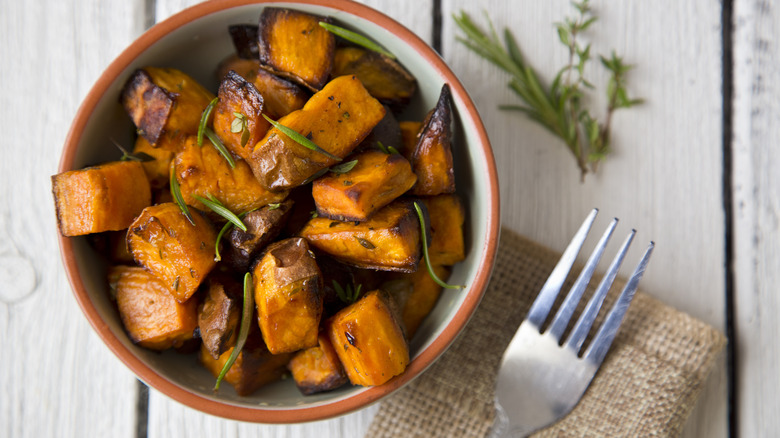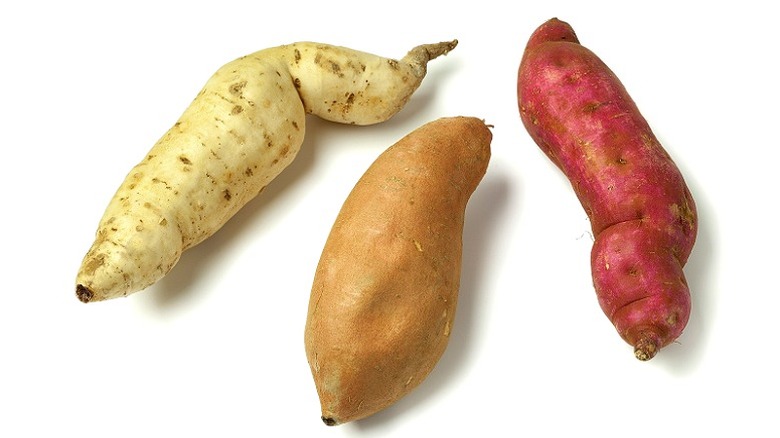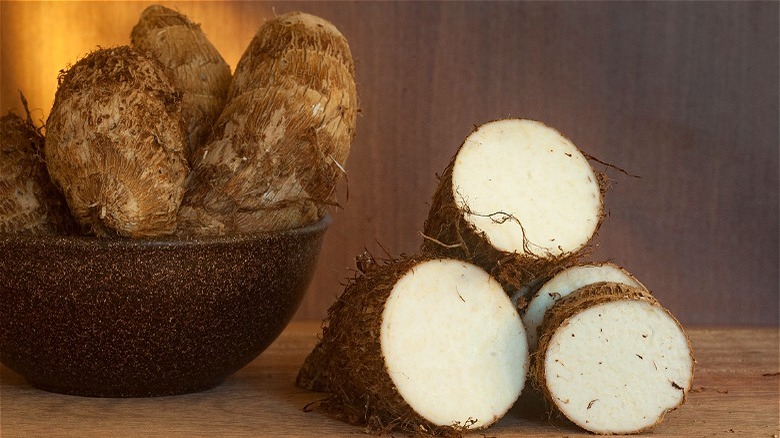Sweet Potatoes Versus Yams: What's The Difference?
You've heard it countless times over the years: You should be incorporating fruits and vegetables into your diet. According to the USDA My Plate recommendation, vegetables are loaded with essential vitamins; adults between the ages of 31 and 59 are advised to consume roughly two to four cups of vegetables per day.
In 2021, the International Fresh Produce Association outlined the most popular vegetable options in the United States. And with so many vegetables available at your fingertips, some of the choices warrant confusion. For example, if you've ever wondered what the difference is between the colors of bell peppers, you're not the only one. The Science Explorer explains that green peppers are the same as red peppers — they just haven't been allowed to ripen before being picked. (Still, each color of bell pepper has a different nutritional makeup.) On the other hand, when you turn your attention to broccolini, Food Network says it's from an entirely different plant family than the popular broccoli.
Now, what about sweet potatoes and yams? They look fairly similar in nature — what's the difference between the two?
The confusion between yams and sweet potatoes
The difference between yams and sweet potatoes denotes a different answer depending on where these tubular root vegetable varieties are sold. According to the Library of Congress, unlike sweet potatoes, yams have foundational roots traced back to Africa, where most of today's varieties still grow. NPR showcases how firm sweet potatoes have been a mainstay in the American diet for thousands of years with ancient evidence traced back to Polynesia, but the bright orange, softer sweet potatoes didn't become a nationwide staple until the mid-1900s. In present-day America, some sweet potato strains are labeled as yams, even at your corner grocery store — but why?
Southern Living explains that in the 1930s, the USDA allowed Louisiana to brand its softer, sweeter tubular varieties as yams to give consumers a clear way to tell the difference between hard and soft types of sweet potatoes. The Washington Post adds that even the candied yams Americans have grown to enjoy on their yearly Thanksgiving tables are, in fact, sweet potatoes. Yet, in actuality, yams are distinctly different from sweet potatoes.
The clear differences between yams and sweet potatoes
Before sitting down to enjoy another baked sweet potato, you may want to know what sets them apart from yams. According to North Carolina Sweet Potatoes, yams often have starchy flesh and a rough brown exterior. Sweet potatoes, meanwhile, have smoother skin, with flesh that can range in color and taste depending on the variety. Appearance aside, Southern Living confirms that yams and sweet potatoes are also from different plant families. While they are both considered tubular root vegetables, yams belong to the lily family, and sweet potatoes are a part of the morning glory family.
What about the taste? Healthline explains that sweet potatoes are generally a lot sweet than yams. Yams are also typically drier due to their starchy makeup. Both vegetables have plenty of nutritional benefits, providing adequate amounts of fiber. But sweet potatoes have significantly more beta-carotene than yams, while yams contain more manganese and potassium (per Healthline).
While sweet potatoes are nearly everywhere in the United States, according to Harold McGee, author of "On Food and Cooking," yams "are seldom seen in mainstream American markets" (via The Washington Post). Southern Living adds that in America, you can find yams at food stores specializing in international foods. So the next time you think you're enjoying a yam, unless the vegetable was purchased at a specialty grocer, the truth is, you're probably eating a sweet potato.


